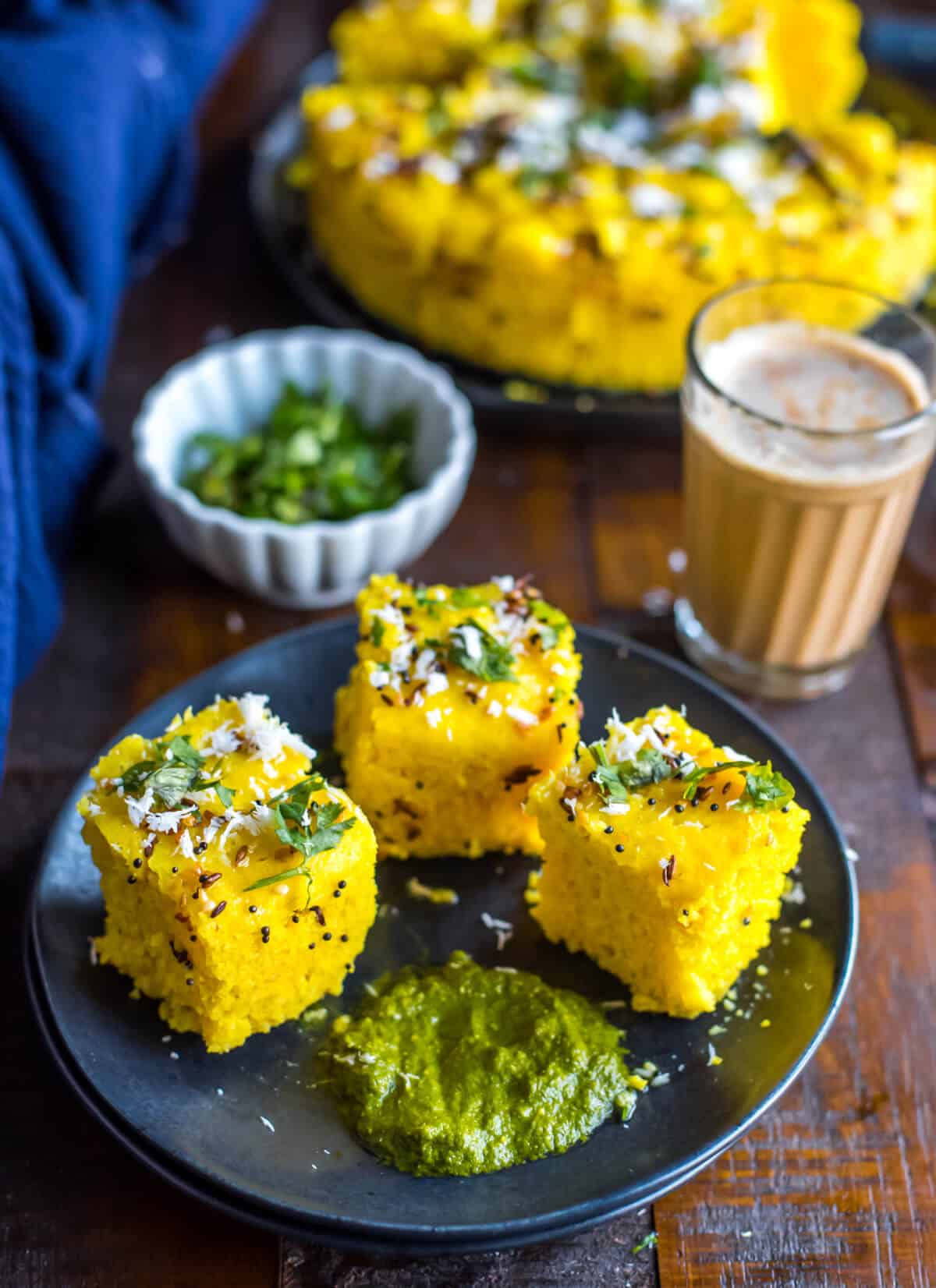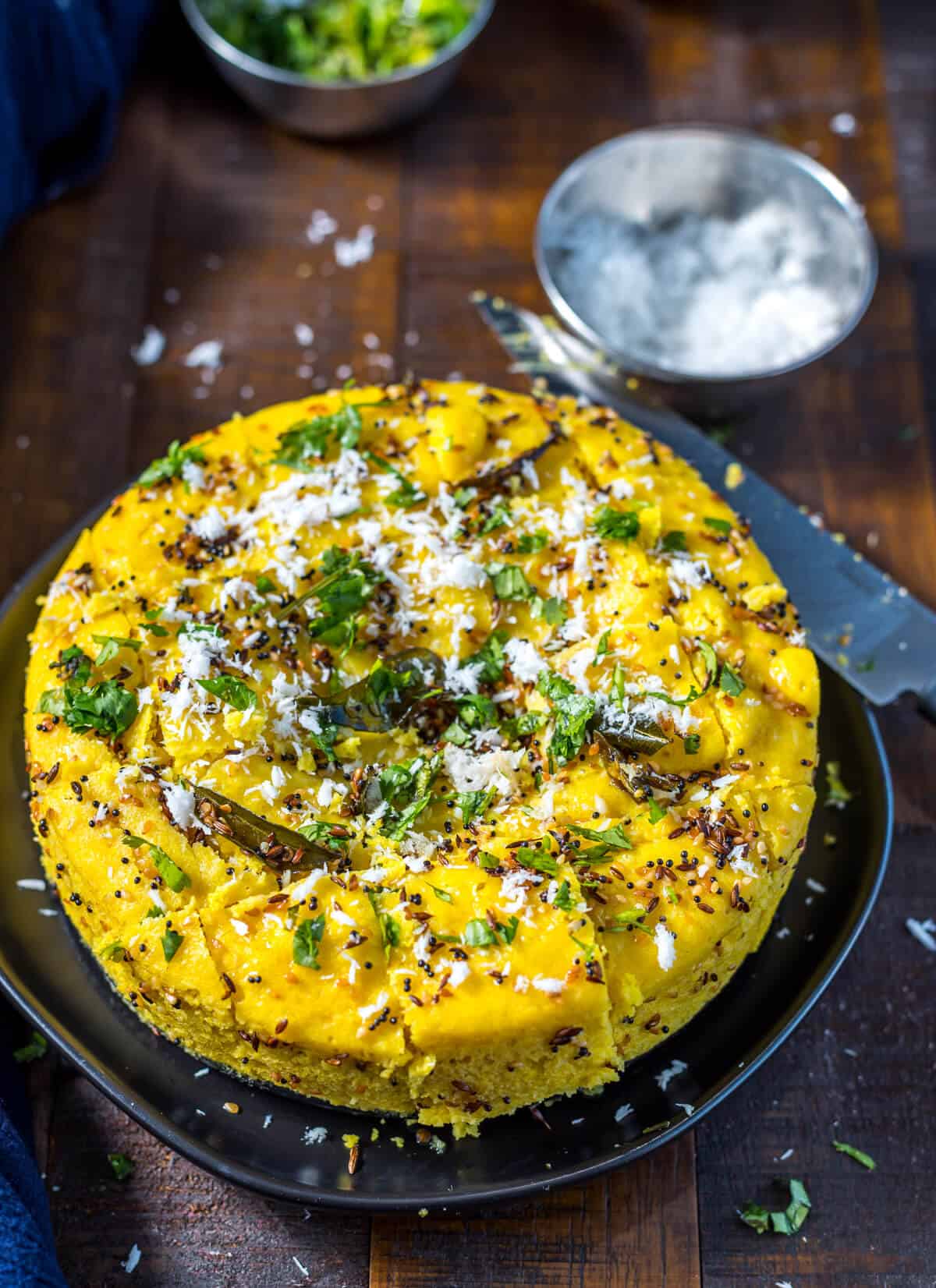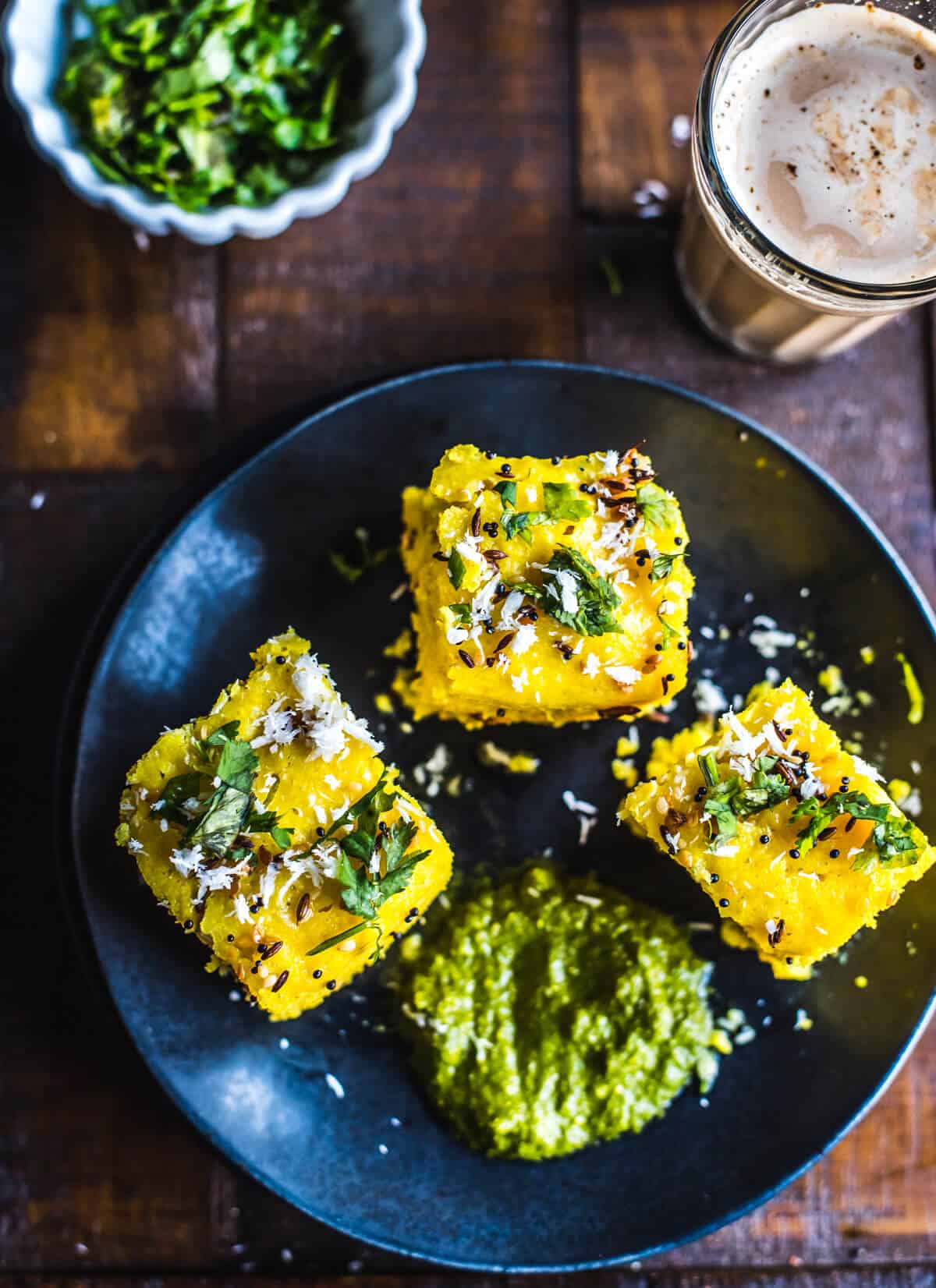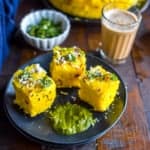Failproof Instant Nylon Khaman Dhokla
Note: This post contains affiliate links. As an Amazon Associate I earn from qualifying purchases.
Spongy, savory, and with a hint of sweetness, Gujarati nylon khaman dhokla is a light and healthy anytime snack. Get this failproof recipe to make this soft and fluffy khaman in the Instant Pot.

What is khaman?
I grew up in a predominantly Gujarati-speaking neighborhood, which meant I had easy access to spongy khaman, rava dhokla, Gujarati dal, kadhi, via my friend’s lunch boxes or the neighborhood store.
Amongst all the Gujarati food, khaman was my absolute favorite. If you never had this dish, imagine a bright yellow savory cake that is soft and fluffy. When you take a bite of this steamed cake along with green chutney, it just melts away in your mouth.
Traditionally, this dish is made by soaking chana dal in water for a few hours before grinding it to a fine paste. This paste is mixed with yogurt and left overnight to ferment. It is then cooked by steaming and finished by adding a tempering of oil, spices, sugar, and water.
In recent times, though, most folks prefer this instant version – instead of soaking and grinding chana dal, they use besan or Bengal gram flour. Hence the name of the dish – Instant Khaman.
Don’t mistake this for rava dhokla, they are two very different dishes, and you are about to find out how..
What is the difference between khaman and dhokla?
Both dhokla and khaman (also called nylon dhokla) are two different dishes originating from Gujarat. Most people (including me) use the names interchangeably, but khaman and dhokla are not one and the same, as I learned from my Gujarati friends. They taught me that these two are very different dishes with different ingredients.
Here are the differences:
- Ingredients: Dhokla batter is made from a mixture of rice and lentils, whereas khaman is made from a batter of gram flour (besan in Hindi).
- Color: There is a difference in the color of the two dishes, too. While khaman is brighter and deeper yellow, dhokla is whitish in color.
- Texture: Khaman is soft, spongy, and has a melt-in-the-mouth texture, which is why it is known as nylon khaman. Dhokla can be spongy as well but is a tad bit denser than khaman.
Of the two, khaman is more commonly sold in the market and is most often referred to as Dhokla, which, of course, is the wrong name for the dish.
Alternate names: Yellow dhokla, Besan dhokla, Instant dhokla, Gujarati Nylon khaman
Reasons to love this recipe
Here are the many reasons we love this khaman dhokla recipe
- This spongy dhokla makes for a perfect snack that comes together in 30 minutes.
- It is ideal for parties, making it a convenient make-ahead option.
- The sweet and savory taste and cake-like texture make this instant dhokla a hit among adults and kids!
How to make Gujarati khaman dhokla in Instant Pot

Ingredient notes/swaps
Here’s what you need to make this Instant khaman dhokla –
- Besan (Bengal gram flour) – This recipe calls for Bengal gram flour and NOT chickpea flour.
- Fine semolina – adds texture to this dish.
- Turmeric powder – for that beautiful yellow hue and medicinal properties.
- Sugar – for a hint of sweetness
- Citric acid crystals (nimbu ke phool) – gives khaman its characteristic tangy flavor.
- Green chili – for a hint of heat.
- Ginger – for flavor
- Oil – for moisture and softness
- Fruit salt (Eno) – a leavening agent that helps the khaman rise and become fluffy.
Tempering ingredients
The following ingredients are used in the tempering process, adding a perfect finishing touch to this delicious snack.
- Oil, mustard seeds, cumin seeds – Mustard seeds provide a slightly nutty and pungent taste, while cumin seeds offer an earthy and warm flavor.
- Asafoetida adds a pungent, umami-like flavor that complements the other spices.
- Curry leaves – for its aroma
- Sesame seeds – for a delightful crunch and nutty flavor
- Green chillies – for a spicy kick
- Water – softens the dhokla and helps it absorb all the flavors from the tempering.
- Sugar – for a hint of sweetness
For garnishing
- Cilantro
- Grated coconut
Be sure to check out the full recipe and ingredient list below.
Those who have tried making nylon khaman will clearly understand what I mean when I say this – making khaman can be tricky. There are several things that can go wrong, such as
- The khaman does not rise and ends up being dense.
- The khaman does not cook through.
- The dish has a bitter aftertaste.
Don’t worry – this recipe has been tested multiple times, and I’ll share my tips with you so that you never have a failed dish.
Expert Tips
- Gram flour is not the same as chickpea flour: Avoid using chickpea flour; it’s not the same as gram flour. Gram flour is derived from split black chickpeas (chana dal), whereas chickpea flour is made from garbanzo beans (or safed chana). To understand these pulses better, check out this article – Pulses 101. I recommend sticking to gram flour for the authentic recipe.
- Add Eno fruit salt just before steaming: Always remember to add Eno fruit salt just before steaming. Immediate steaming is crucial for proper batter rising.
- Use a fresh batch of Eno: The main ingredient that makes the Khaman soft and spongy is fruit salt. Don’t use it if it is too old. Ideally, when you add fruit salt, the batter should become light and airy. This indicates that the fruit salt has done its magic. If that doesn’t happen, use a new batch of fruit salt.
- Check for doneness: Insert a toothpick into the center of the Khaman. If it doesn’t come out clean, steam it for an additional 3-4 minutes until thoroughly cooked.
- Beware of expired gram flour: If your Khaman has an odd aftertaste, it may be due to expired gram flour. Use a fresh batch next time.
- Covered vs. uncovered cooking: I recommend making Khaman uncovered since the batter rises as it cooks. If you prefer covering, use a deeper bowl to avoid it sticking to the foil or lid.
- Steam valve position: The steam valve needs to be set to venting to replicate the steaming function involved in traditionally making khamans. If you set the valve to sealing, the khaman ends up a tad bit denser.
- Generous water in tempering: Add 1/2 cup of water in the tempering, even though it might seem excessive. This water helps achieve the soft, spongy, and melt-in-the-mouth texture characteristic of nylon Khaman. And don’t worry; the khaman will soak up all the water in a few minutes. Just make sure to distribute that tempering evenly, and don’t miss the edges!
Step-by-step instructions

Preparing the khaman batter
- Grease a 7-inch springform pan or a steel bowl either using oil or cooking spray.
- Add gram flour, semolina, sugar, turmeric powder, citric acid crystals, green chili, ginger, oil, salt, and water in a mixing bowl. Use a whisk to combine them into a lump-free batter.
Steaming khaman
- Add 2.5 cups of water to the Instant Pot, click on the Saute function, and set it to the ‘More’ mode. Once the water comes to a boil, hit warm/cancel.
- Add the Eno fruit salt to the batter and mix it in till it gets incorporated into the batter. Do not overmix.
- Transfer the batter to the springform pan.
- Place the trivet in the steel inner pot along with the springform pan. Cover the Instant Pot with the lid and set the valve to the venting position.
- Select the ‘Steam’ function and adjust the pressure to high. Set an external timer to 20 minutes. [Note: When the steam valve is in the venting position, the Instant Pot timer will not work]
- Once the external timer indicates the time is up, hit the cancel button in the Instant Pot.
- Wait for 5 minutes, and then open the lid.
- Insert a toothpick right in the center of the khaman. If it doesn’t come out clean, steam the khaman for an additional 3-4 minutes till it is thoroughly cooked.
- Remove the pan carefully using tongs. If using a springform pan, unhinge the clasp and remove the sides.
- If you are not using a springform pan, run over the edges of the pan with a sharp knife and invert the khaman over a plate. Lift the pan off the khaman.
- If you prefer the smoother surface to be on top, invert the khaman one more time by keeping a plate on top of the khaman. Carefully hold both plates together and flip the bottom plate to the top.
- Remove the plate and cut the khaman into square or diamond shapes.
Tempering process
- Add oil to a small pan and set it on medium heat.
- Once the oil is hot, add mustard and cumin seeds, and when they start to crackle, add asafoetida, green chilies, sesame seeds, and curry leaves.
- When the sesame starts to brown in about 10-15 seconds, take the pan off the heat.
- Add water and sugar into the pan and mix well.
- Pour this tempering mixture evenly over the khaman using a spoon.
- Give the khaman about 5 minutes to soak up all the water and soften up.
- Garnish with grated coconut and finely chopped cilantro.
- Serve with green chutney.
Variations and substitutions
- Eno substitute – If you don’t have Eno fruit salt, substitute it with 1/2 teaspoon citric acid + 1/2 teaspoon baking soda. However, I personally prefer using Eno as it imparts a better taste and fluffier texture to the dish.
- Citric acid substitute – The recipe calls for 1/2 teaspoon of citric acid, and it can be substituted with 2 tablespoons of lemon or lime juice.
Serving suggestions
Serve this instant Khaman Dhokla with your choice of cilantro chutney or tamarind chutney—it’s a delicious pairing either way!
Prep and storage instructions
This besan dhokla is an excellent choice for a party snack. You can prepare it a few days in advance, and it will maintain its delicious taste.
Prep ahead – I have also frozen leftover khaman in the past without any significant impact on the taste. To freeze, place it in an airtight freezer-safe container. You can reheat it in the microwave without thawing.
Reheating instructions – Warm the leftover dhokla in the microwave or steam it for a few minutes before serving.

If you are looking for easy and delicious Indian breakfast recipes, here are my top picks,
- Lemon vermicelli – This delicious and tangy Semiya Upma (Lemon Vermicelli) is just what you need to start your day. It is filling and comes together in 15 minutes from start to finish.
- Sooji ka upma – a semolina-based breakfast dish that takes less than 30 minutes.
- Idli – You’ll love this post if you have been struggling to get soft and spongy idlis. Learn all my tips and tricks to get perfect fermented batter even in winter!
- Buttermilk dosa – Buttermilk dosa – Delicious and soft, this dosa is perfect for breakfast, snacks, and even lunch. Learn how to make it in a few easy steps.
- Instant Rava idli – Here is a quick recipe to enjoy those lovely, soft, fluffy instant rava idlis whenever the mood strikes. Serve with coconut or peanut chutney for a delicious and healthy meal.

Instant Gujarati Khaman Dhokla Recipe
Equipment
Ingredients
- 1.5 cups Bengal gram flour Besan
- 1.5 tablespoons fine semolina rawa
- 0.5 teaspoon turmeric powder
- 1 tablespoon sugar
- 0.5 teaspoon citric acid crystals nimbu ke phool
- 1 green chili finely chopped
- 1 inch piece ginger grated
- 1 teaspoon oil avocado or peanut
- 1 teaspoon salt
- 1 cup water for the batter
- 1.5 teaspoons fruit salt or Eno
- 2.5 cups water for steaming
For the tempering
- 1 tablespoon oil avocado or peanut
- ½ teaspoon mustard seeds
- ½ teaspoon cumin seeds
- ⅛ teaspoon asafoetida
- 7-8 curry leaves
- ½ teaspoon sesame seeds
- 3-4 green chilies, slit lengthwise
- ½ cup water
- 3 teaspoons sugar
For garnishing
- ¼ cup finely chopped cilantro/coriander leaves
- 1 tablespoon grated coconut optional
Instructions
Preparing the batter
- Grease a 7-inch springform pan or a steel bowl either using oil or cooking spray.
- Add gram flour, semolina, sugar, turmeric powder, citric acid crystals, green chili, ginger, oil, salt and water in a mixing bowl. Use a whisk to combine them into a lump-free batter.
Steaming
- Add 2 cups of water in the Instant Pot and click on the Saute function and set it to the ‘More’ mode. Once the water comes to a boil, hit warm/cancel.
- Add the Eno fruit salt to the batter and mix it in till it gets incorporated into the batter. Do not over mix.
- Transfer the batter into the springform pan.
- Place the trivet in the steel inner pot along with the springform pan. Cover the Instant Pot with the lid and set the valve to the venting position.
- Select the ‘Steam’ function and adjust the pressure to high. Set an external timer to 20 minutes. [Note: When the steam valve is in the venting position, the Instant Pot timer will not work]
- Once the external timer indicates the time is up, hit the cancel button in the Instant Pot.
- Wait for 5 minutes and then open the lid.
- Insert a toothpick right in the center of the khaman. If it doesn't come out clean, steam the khaman for an additional 3-4 minutes till it is thoroughly cooked.
- Remove the pan carefully using tongs. If using a springform pan, unhinge the clasp and remove the sides.
- If you are not using a springform pan, run over the edges of the pan with a sharp knife and invert the khaman over a plate. Lift the pan off the khaman.
- If you prefer a smoother surface on top, invert the Khaman once more. Place a plate on top of the khaman and carefully hold both plates together. Flip the bottom plate to the top.
- Remove the plate and cut the khaman into diamond or square shapes.
Tempering process
- Add oil to a small pan and set it on medium heat.
- Once the oil is hot, add mustard and cumin seeds and when they start to crackle, add asafoetida, green chilies, sesame seeds, and curry leaves.
- When the sesame starts to brown in about 10-15 seconds, take the pan off the heat.
- Add water and sugar into the pan and mix well.
- Pour this tempering mixture evenly over the khaman using a spoon.
- Give the khaman about 5 minutes to soak up all the water and soften up.
- Garnish with grated coconut and finely chopped cilantro.
- Serve warm with green chutney.
Notes
Substitutions/variations
-
- Eno substitute – If you don’t have Eno fruit salt, substitute it with 1/2 teaspoon citric acid + 1/2 teaspoon baking soda. However, I personally prefer using Eno as it imparts a better taste and fluffier texture to the dish.
-
- Citric acid substitute – The recipe calls for 1/2 teaspoon of citric acid, and it can be substituted with 2 tablespoons of lemon or lime juice.
Expert Tips
-
- Gram flour is not the same as chickpea flour: Avoid using chickpea flour; it’s not the same as gram flour. Gram flour is derived from split black chickpeas (chana dal), whereas chickpea flour is made from garbanzo beans (or safed chana). To understand these pulses better, check out this article – Pulses 101. I recommend sticking to gram flour for the authentic recipe.
-
- Add Eno fruit salt just before steaming: Always remember to add Eno fruit salt just before steaming. Immediate steaming is crucial for proper batter rising.
-
- Use a fresh batch of Eno: The main ingredient that makes the Khaman soft and spongy is fruit salt. Don’t use it if it is too old. Ideally, when you add fruit salt, the batter should become light and airy. This indicates that the fruit salt has done its magic. If that doesn’t happen, use a new batch of fruit salt.
-
- Check for doneness: Insert a toothpick into the center of the Khaman. If it doesn’t come out clean, steam it for an additional 3-4 minutes until thoroughly cooked.
-
- Beware of expired gram flour: If your Khaman has an odd aftertaste, it may be due to expired gram flour. Use a fresh batch next time.
-
- Covered vs. uncovered cooking: I recommend making Khaman uncovered since the batter rises as it cooks. If you prefer covering, use a deeper bowl to avoid it sticking to the foil or lid.
-
- Steam valve position: The steam valve needs to be set to venting to replicate the steaming function involved in traditionally making khamans. If you set the valve to sealing, the khaman ends up a tad bit denser.
-
- Generous water in tempering: Add 1/2 cup of water in the tempering, even though it might seem excessive. This water helps achieve the soft, spongy, and melt-in-the-mouth texture characteristic of nylon Khaman. And don’t worry; the khaman will soak up all the water in a few minutes. Just make sure to distribute that tempering evenly, and don’t miss the edges!
Disclaimer: Approximate nutritional information is provided as a courtesy and can vary depending on the exact ingredients/brands used. If you have health issues, please work with a registered dietician or nutritionist.
Nutrition
This post was originally written on Jan 7, 2020, and was republished with additional information on Oct 11, 2021, and Dec 8, 2023.



